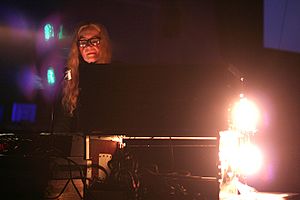Maryanne Amacher facts for kids
Quick facts for kids
Maryanne Amacher
|
|
|---|---|

Maryanne Amacher 2006-10-06
|
|
| Background information | |
| Born | February 25, 1938 Kane, Pennsylvania |
| Died | October 22, 2009 (aged 71) |
| Genres | Electronic music, experimental music |
| Occupation(s) | Composer, installation artist |
| Instruments | Piano |
Maryanne Amacher (born February 25, 1938 – died October 22, 2009) was an American composer and artist. She was famous for her unique work with sounds that your own ears can create! These sounds are called "auditory distortion products" or "ear tones."
Contents
About Maryanne Amacher
Maryanne Amacher was born in Kane, Pennsylvania. Her mom was a nurse, and her dad worked on freight trains. She was an only child and started playing the piano when she was young.
Early Life and Education
Maryanne went to the University of Pennsylvania on a full scholarship. She earned her degree in 1964. There, she studied music composition with famous composers like George Rochberg and Karlheinz Stockhausen. She also studied in Salzburg, Austria, and Dartington, England. Later, she learned about acoustics and computer science at the University of Illinois at Urbana-Champaign.
City Links: Connecting Sounds
In 1967, while at the University at Buffalo, Maryanne created a special project called City Links: Buffalo. This was a 28-hour-long piece of music. She used five microphones placed in different parts of the city. The sounds were broadcast live on the radio station WBFO.
There were 21 other "City Links" projects. Maryanne often used special telephone lines to connect sounds from different places. This created a new kind of "telematic performance." It was like bringing the sounds of one place into another space.
Creating Unique Sound Art
Maryanne's main artworks were often made for specific places. She used many loudspeakers to create what she called "structure borne sound." This is different from sound that travels through the air. She would place speakers in unusual ways, like facing walls or floors. This made listeners hear "sound shapes" or feel a "presence" in the room.
Her early works include three main series:
- "City Links 1–22" (starting in 1967) – these were about connecting sounds from far away.
- "Music for Sound-Joined Rooms" (starting in 1980) – these used the architecture of buildings.
- "Mini-Sound Series" (starting in 1985) – these were new multimedia art forms.
Working with Other Artists
Maryanne was invited to work with John Cage, another famous composer, at Harvard University and MIT. They worked on projects like a storm soundtrack for Cage's "Lecture on the Weather" (1975). She also created sound environments for Cage's "Empty Words" (1978). From 1974 to 1980, she also worked with dancer and choreographer Merce Cunningham on a piece called "Torse."
The Science of Ear Tones
Maryanne Amacher was very interested in sounds that your own ears make. These are called 'auditory distortion products' or 'otoacoustic emissions'. Simply put, when two sounds are played together, your ears can sometimes create a third, new sound!
What are Ear Tones?
These "ear tones" have been known for a long time. Musicians sometimes call them 'combination tones' or 'difference tones'. Maryanne herself called them 'ear tones' until 1992. Then, she learned about scientific research that explained how ears produce these sounds.
She found that some of the sounds she was creating were a type of 'distortion product otoacoustic emissions' (DPOAE). These sounds seem to come from inside your head, as if there's a tiny speaker in your ear! Maryanne was the first artist to really explore how to use these ear-made sounds in her music.
Experiencing the Music
Maryanne described how her music worked:
When played at the right sound level, which is quite high and exciting, the tones in this music will cause your ears to act as neurophonic instruments that emit sounds that will seem to be issuing directly from your head ... (my audiences) discover they are producing a tonal dimension of the music which interacts melodically, rhythmically, and spatially with the tones in the room. Tones 'dance' in the immediate space of their body, around them like a sonic wrap, cascade inside ears, and out to space in front of their eyes ... Do not be alarmed! Your ears are not behaving strange or being damaged! ... these virtual tones are a natural and very real physical aspect of auditory perception, similar to the fusing of two images resulting in a third three dimensional image in binocular perception ... I want to release this music which is produced by the listener ...
She wanted listeners to realize that their own ears were part of the music!
Awards and Influence
Maryanne Amacher received many awards for her work. In 1998, she got a Grants to Artists Award from the Foundation for Contemporary Arts. In 2005, she won the Golden Nica award at Prix Ars Electronica for her project "TEO! A sonic sculpture".
Maryanne Amacher was an important influence for other composers, like Rhys Chatham and Thurston Moore. For the last ten years of her life, she taught at the Bard College MFA program.
In 2020, the New York Public Library got Maryanne Amacher's archives. This means her important work and notes are saved for future generations to study.
See also
 In Spanish: Maryanne Amacher para niños
In Spanish: Maryanne Amacher para niños

